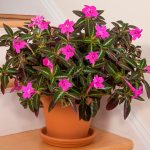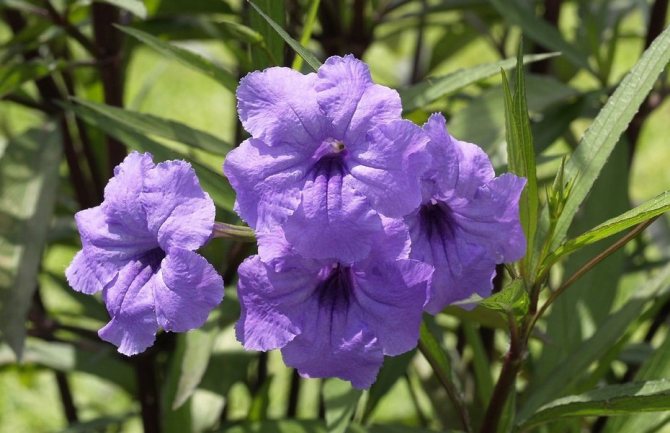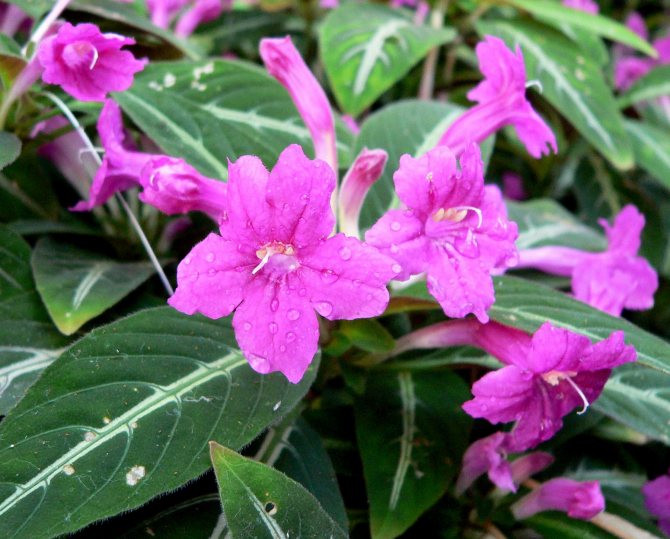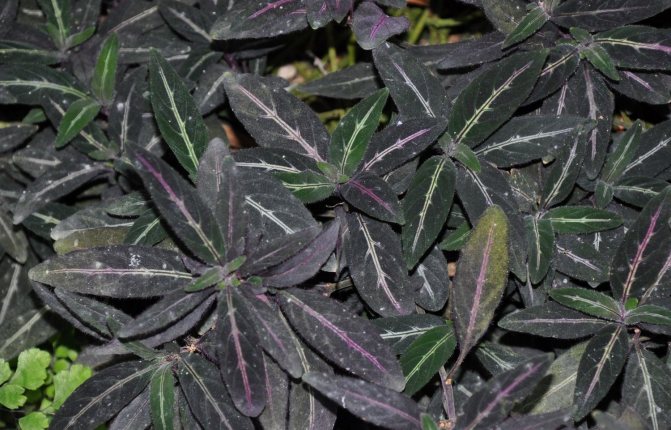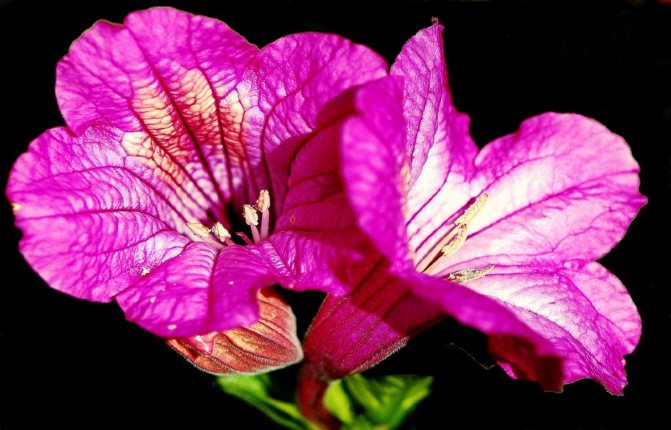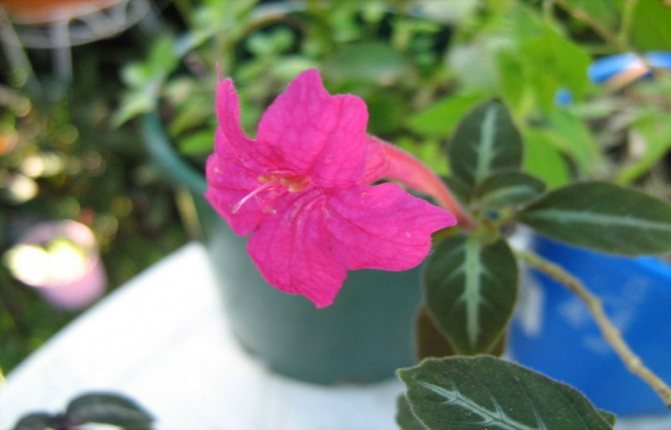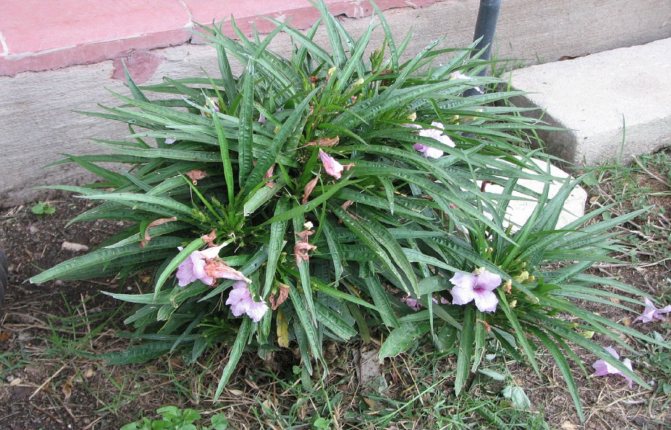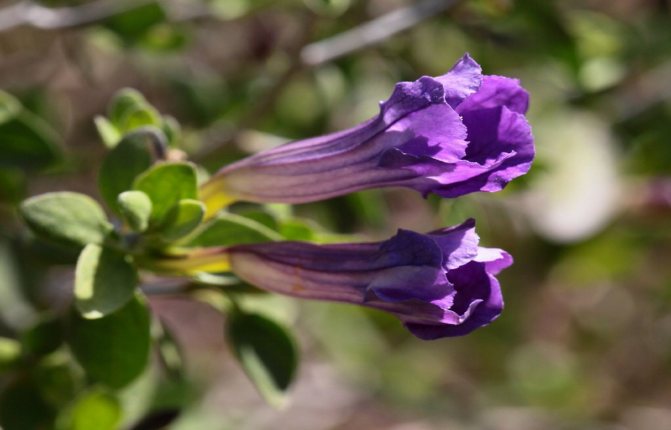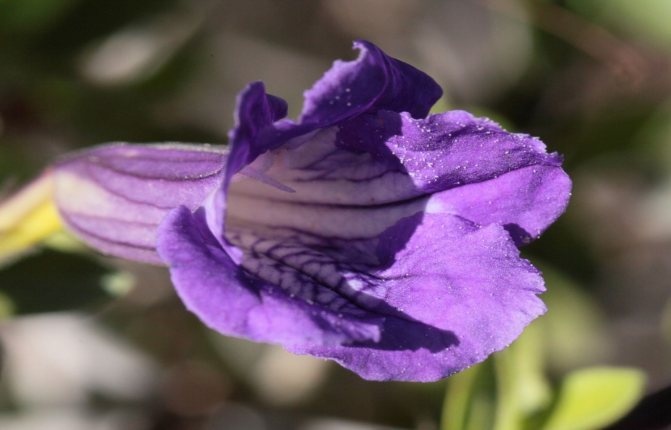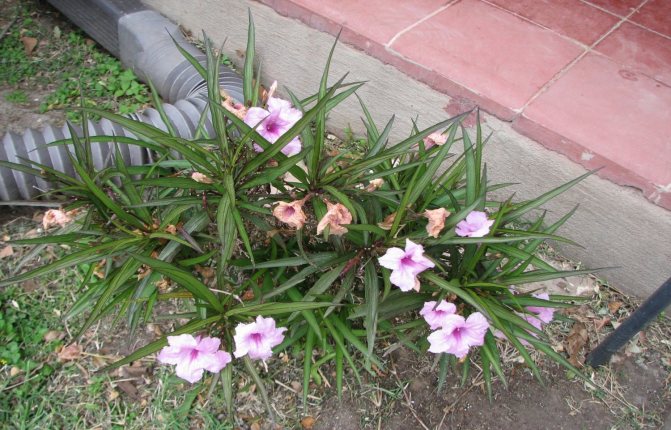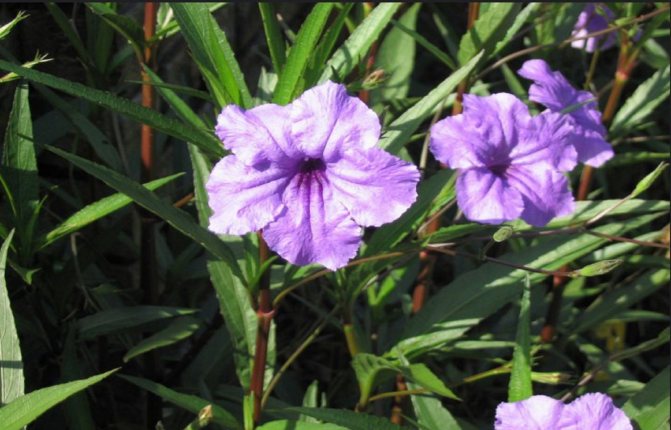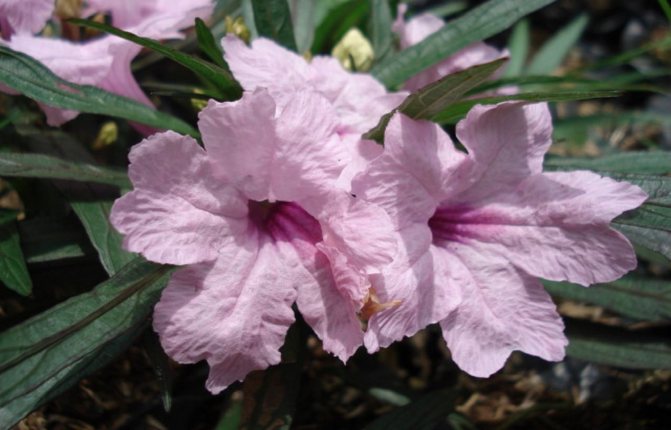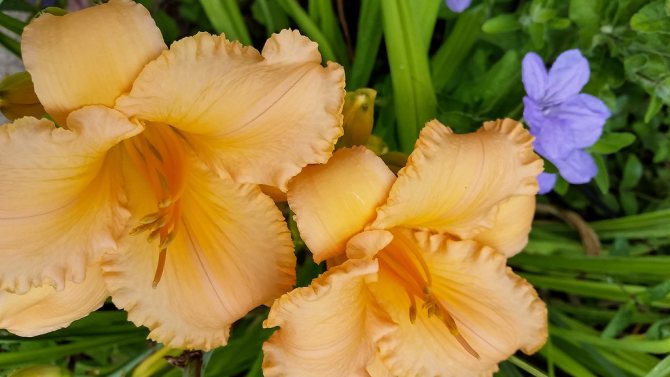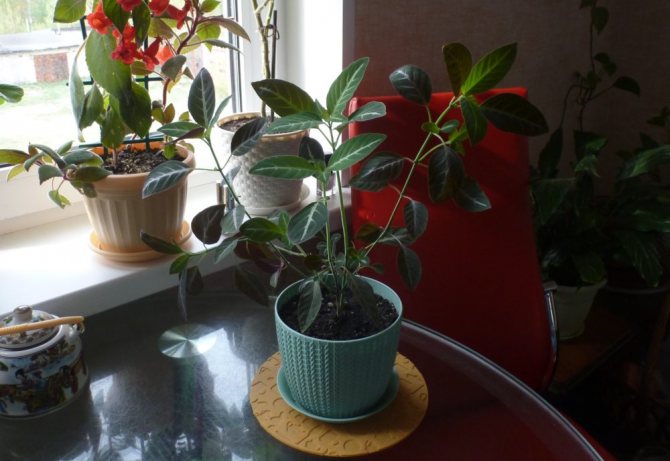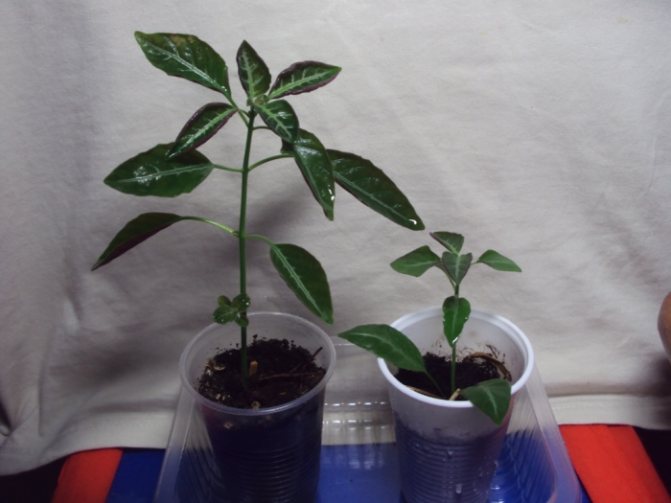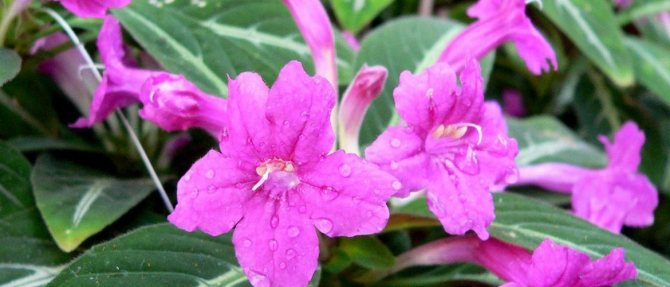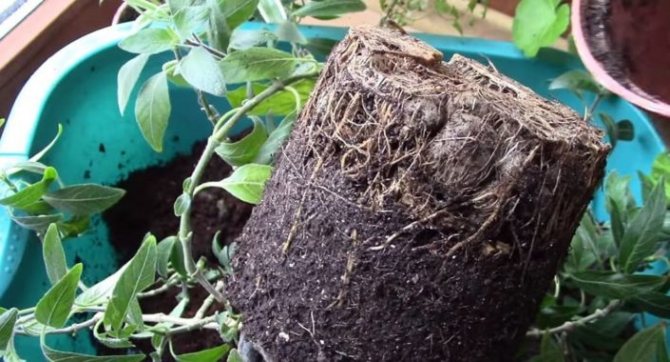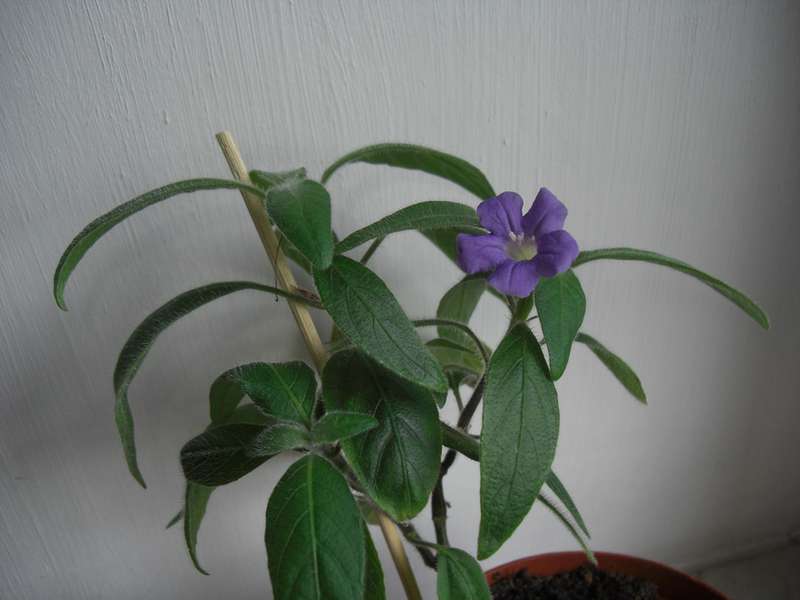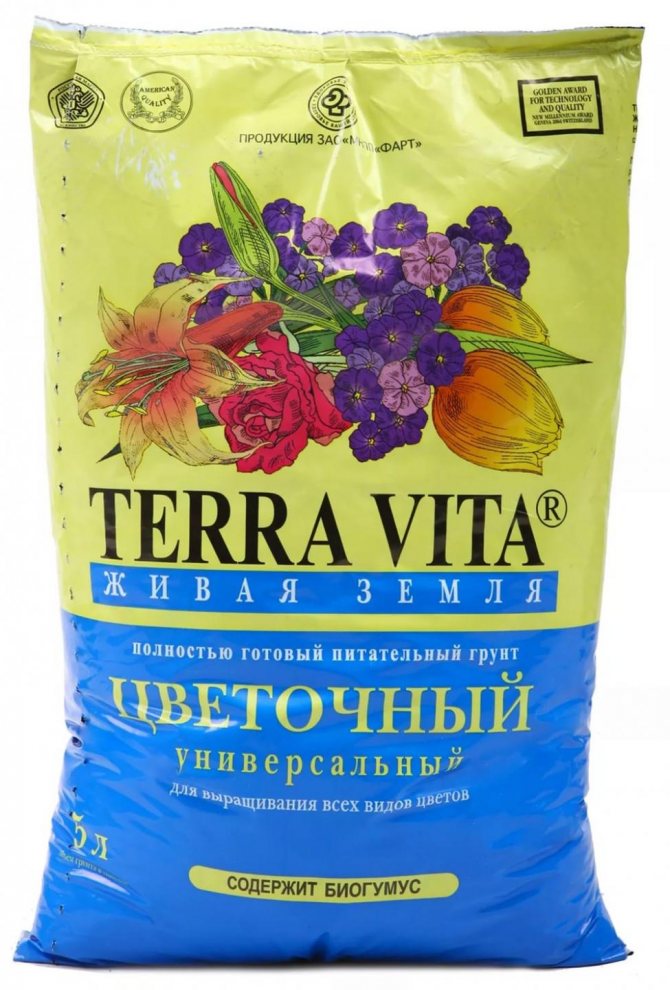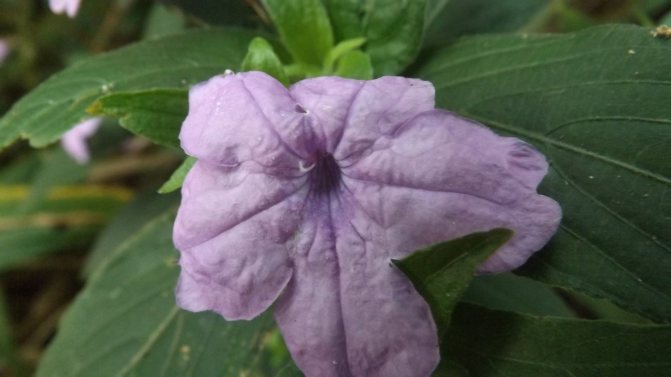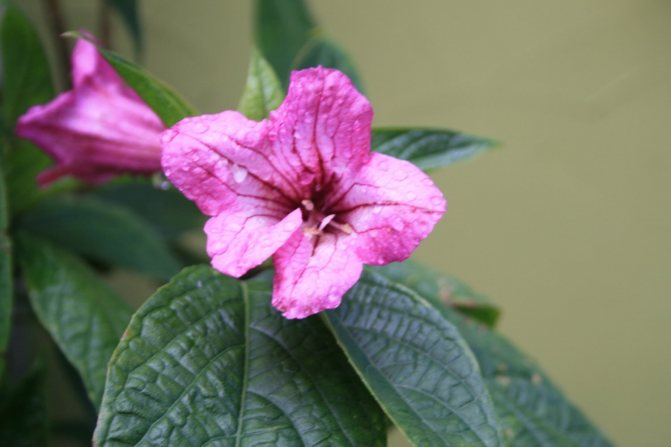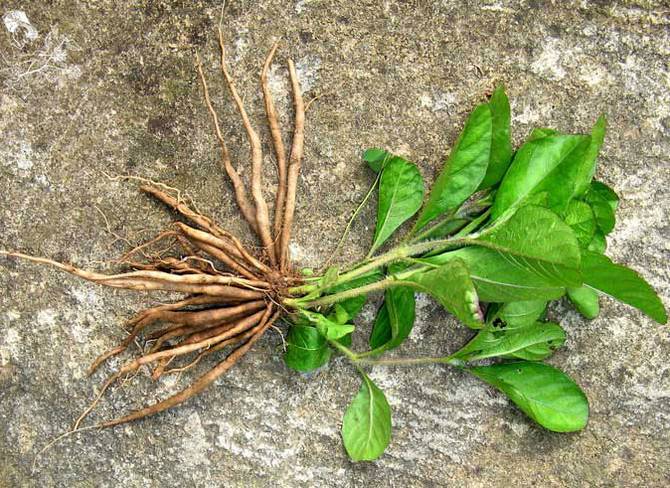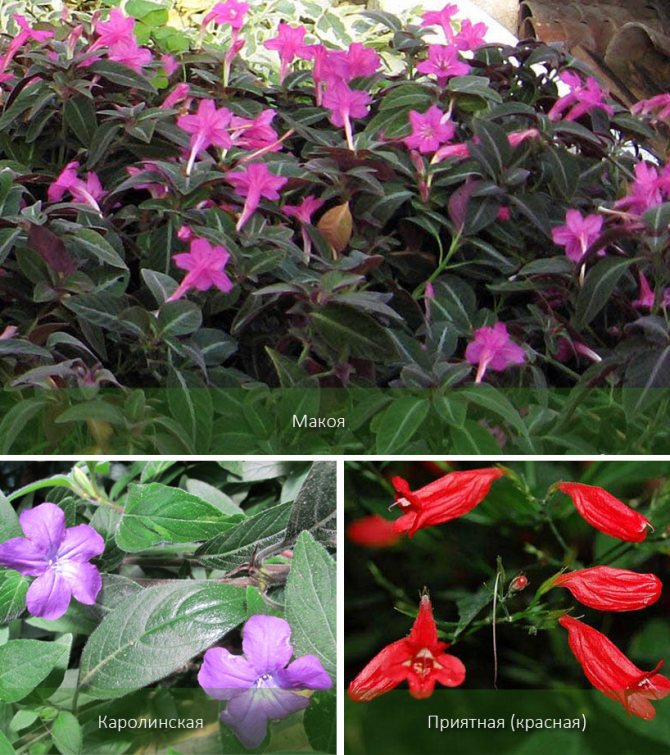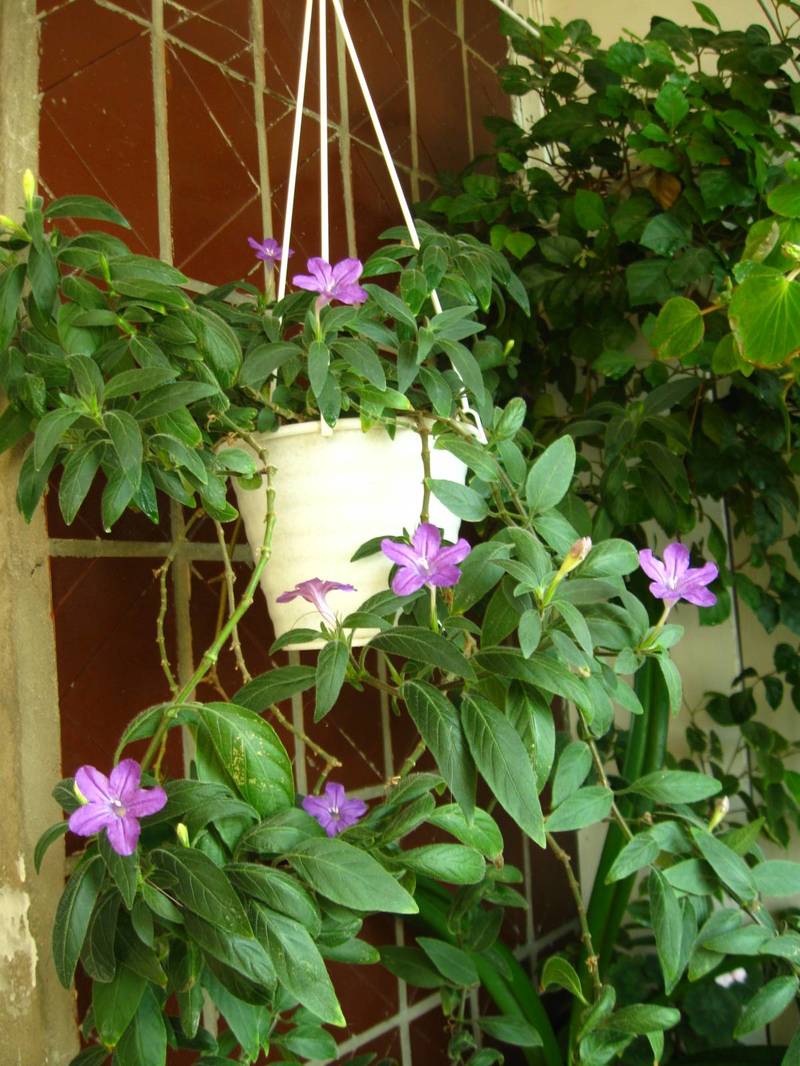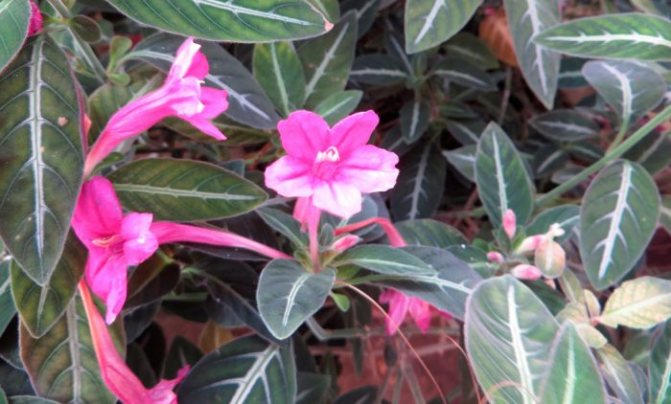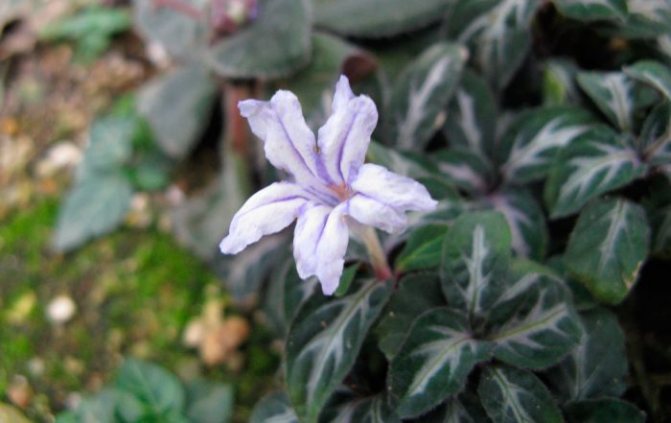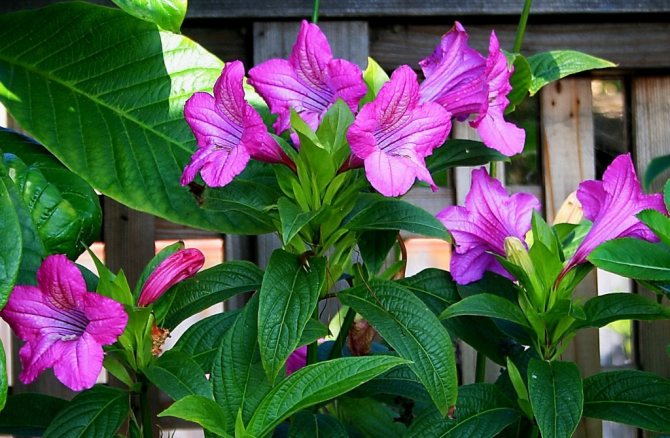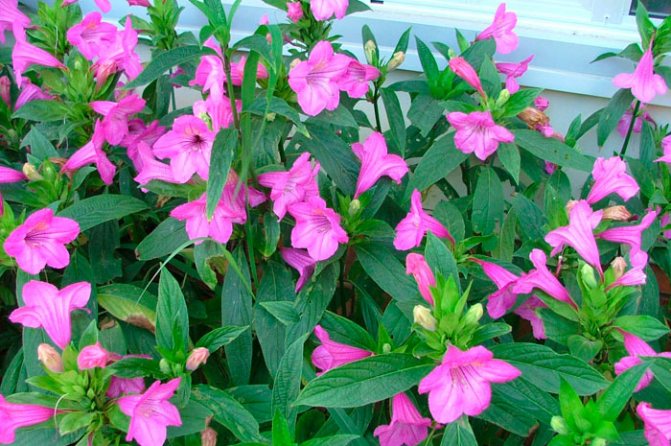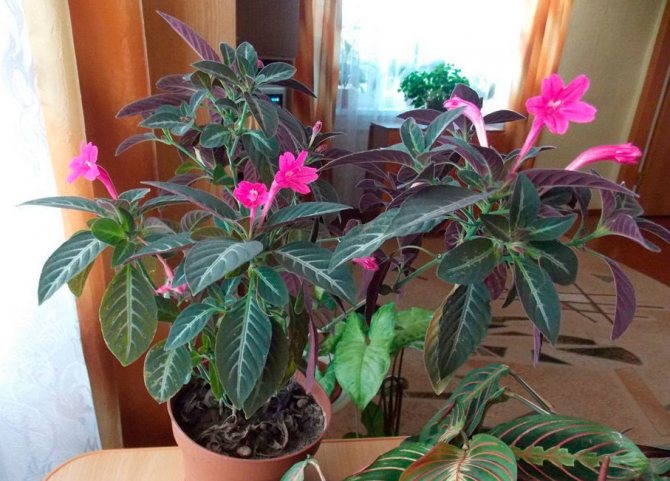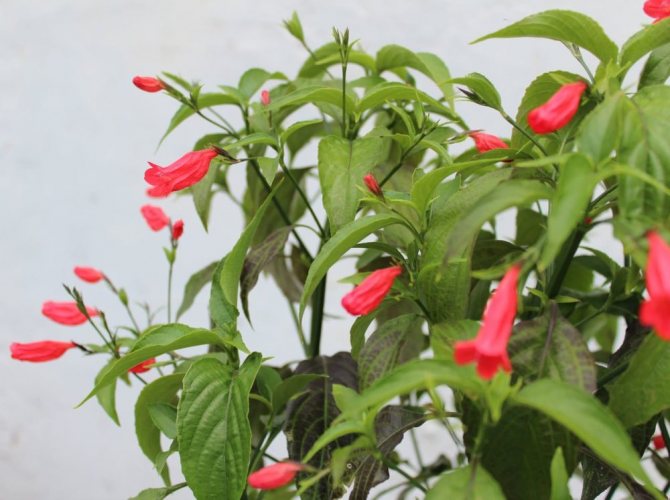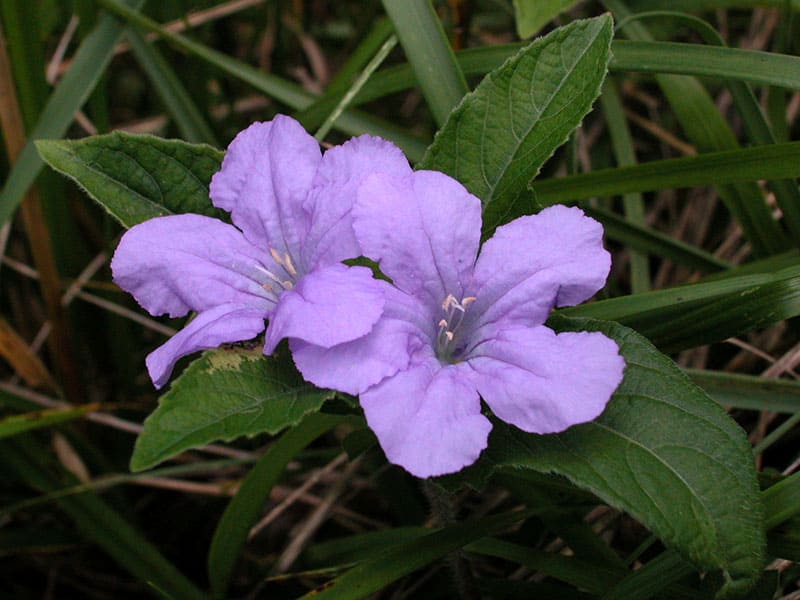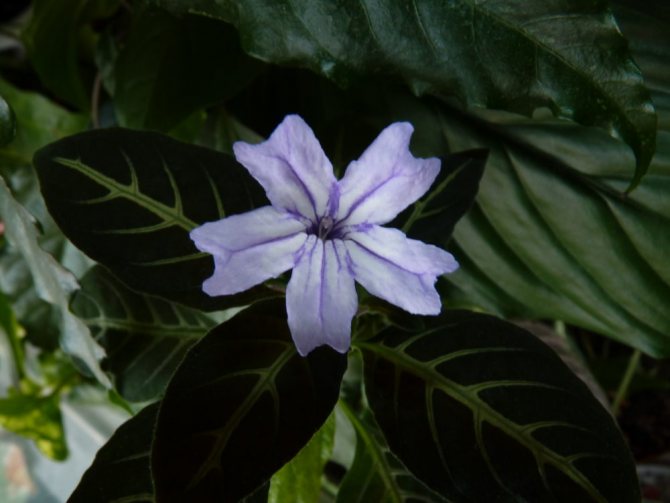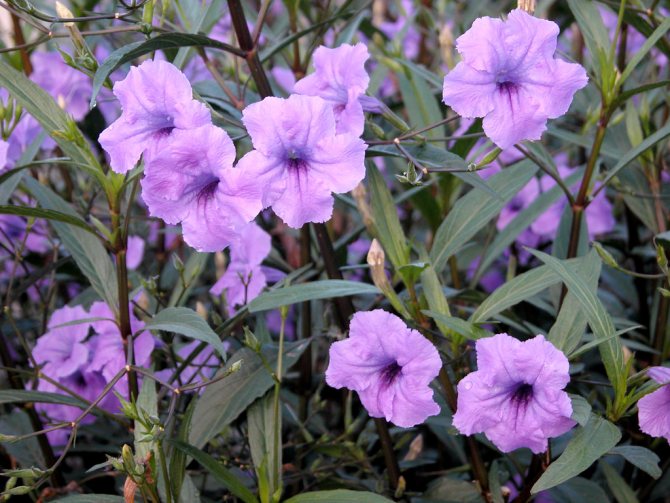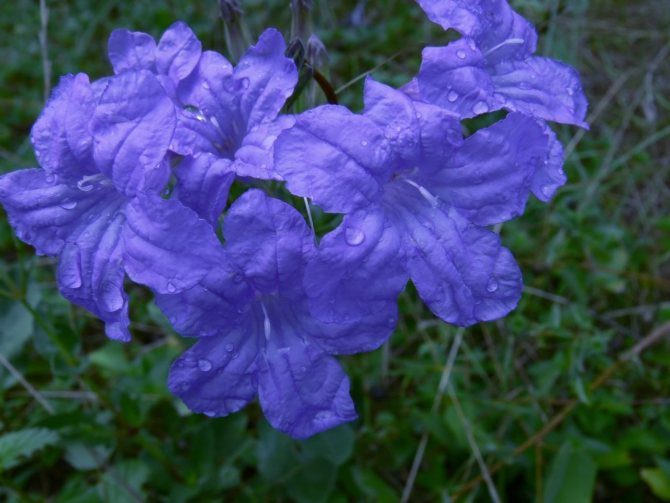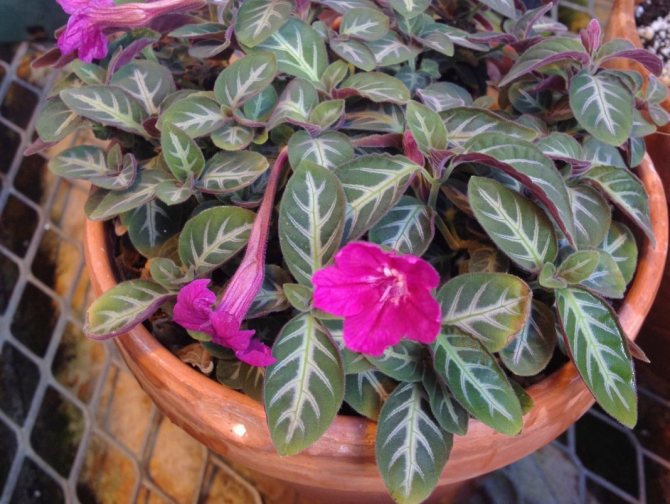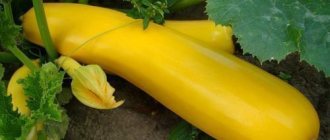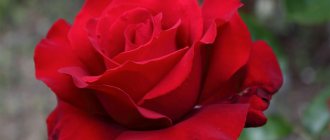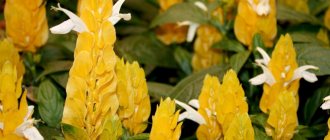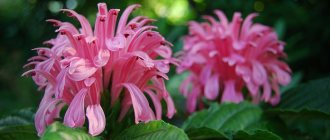Ruellia is a thermophilic plant whose pleasant appearance can beautify any interior. Unfortunately, the flowers of the plant are distinguished by a short flowering, which is why its popularity among flower growers suffers. Flowers bloom and wither within one day. But this is not a reason to give up growing Ruelia, because her velvety leaves are also beautiful, and she looks great both alone and in composition with other flowers. And if we add to this that taking care of Ruella at home does not cause any difficulties, it becomes an excellent purchase solution. The only pity is that it is not so easy to find it in flower shops.
Description of ruelia
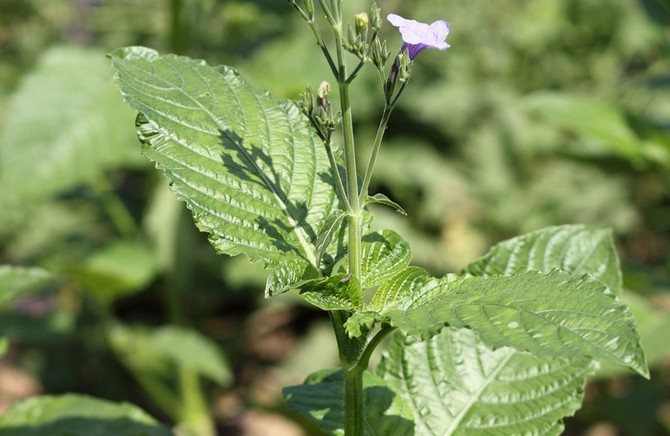
In the wild, the plant is found in Africa, South Asia, the subtropics and tropics of America. Ruellia is grown as a herbaceous plant, dwarf shrubs and shrubs. The flower has a straight, creeping or shallow stem, which has several facets and actively branches. The leaves are usually whole, whole, have an elongated shape and are wide in the middle. The leaves are located opposite each other and have a glossy sheen or a velvet surface with barely noticeable hairs.
At the ends of the shoots, single large flowers appear, which can reach up to 5 cm in length. Ruellia flowers are available in white, beige and purplish pink. Unfortunately, flowers do not last long - you can admire them for only a few hours. When the flower falls, a box of seeds appears in its place. It is interesting to observe how, after ripening, this capsule bursts, shooting its seeds at a great distance.
In bright and diffused light, ruelia can bloom from February to the very end of autumn. In a shaded room, flowering times are reduced to three to four months. The advantages of ruella include the fact that it can bloom in winter, when other plants are dormant.
Important! In most flower shops, you will not find ruelia. Probably due to the rapid flowering, it is not in great demand. But you can always try to find it in private collections of florists.
Flowers for home growing
The flowers of the plant are very attractive. They are formed at the tops of the shoots. The buds are painted in different shades - from white to deep purple. The surface of the corolla is velvety. The tube reaches a length of about 5-6 cm. The flower does not "live" for long. It is quickly pollinated by insects and the bud falls off. After that, if pollination has occurred, a fruit is formed of the type - a box. It is gray in color and shoots out small seeds when ripe.
In floriculture, ruella is used exclusively for home cultivation. There are specimens that are suitable for winter gardens. In Russia, it is not recommended to choose such a plant as a garden plant and grow it outdoors. Inconsistent weather and difficulty in transferring to containers can kill a culture. The evergreen perennial is rarely found as a home plant, especially in flower shops. This is most likely due to the rapid wilting of flowers. If you want to grow such a plant at home or in a winter garden, you will have to try to find a good manufacturer of planting material or somethingwho can share a cut from their own plantings.
Caring for a ruelle flower at home
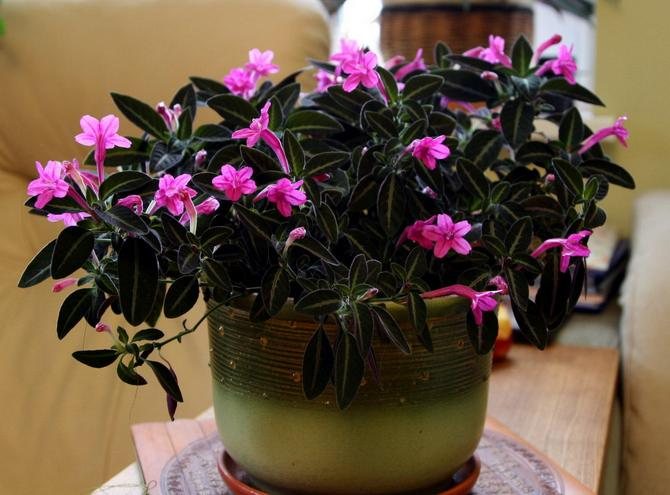

Ruelia does not require special care for her, so her cultivation and maintenance will not take much time.
Location and lighting
It is best to place ruelia on the east and west windows. The plant will bloom in the back of the room, but this requires sufficient lighting, since the ruelia requires a lot of light. Experienced growers use special lamps for plants in order for the plant to bloom all year round.
In the summer, it is important not to overexpose the plant in the sun, otherwise the leaves may simply burn out. In conditions of a lack of lighting, the length of the internodes of the plant will increase, and with intense lighting, the bush will bloom more actively and appear more luxuriant.
Temperature
As for the temperature, the most optimal temperature will be 18 degrees. In winter, the temperature is allowed to drop to 16 degrees.
Watering
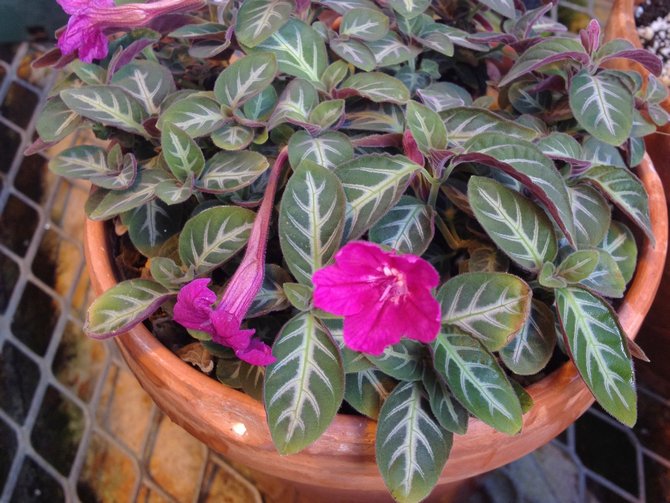

Every time the soil begins to dry out, the plant needs to be watered. Watering should be systematic, but not very plentiful. The plant needs water when the topsoil dries up. A situation should not be allowed when the whole earth is completely dry. As soon as the leaves begin to wither and fall, an urgent need to water the ruelia. Then there is a chance that the plant will bounce back if it has been without water for a short period of time. When the flower is left without watering for a long time, the lower leaves on the stem may fall off.
Air humidity
Ruellia does not require constant spraying. The main thing is that the flower is away from batteries, as well as heaters, since too warm air can stimulate the leaves to fall off the stem. Warm water is good for the plant.
Top dressing and fertilizers
When transplanting ruella, you need to add fertilizer to the soil for flowering plants. When the plant has acclimatized, a combined fertilizer for ornamental indoor plants can be added to the soil about 1-2 times a month.
Transfer
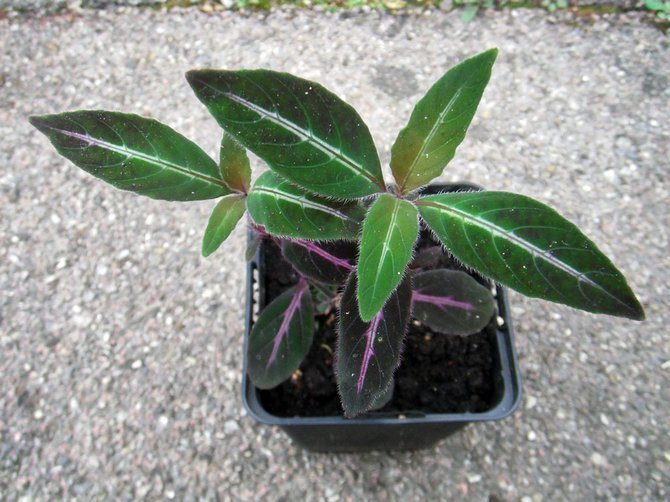

Young plants need to be replanted every year, and adults as needed. It is better to transplant between the beginning of March and the end of May. As a soil, you can use a mixture of sod and leafy soil, humus and sand. As an analogue of this mixture, you can use the usual commercial land for home plants. It will be very useful to put vermiculite in the soil, which will act as a drainage.
Pruning
To make the flower lush and actively branch, pinch the ruelia. For decorativeness and a beautiful appearance, naked shoots are cut off from ruelia, as a result of which new ones begin to form and the effect of splendor is achieved. Alternatively, you can plant a new plant by cutting off the top of the cutting.
Transfer
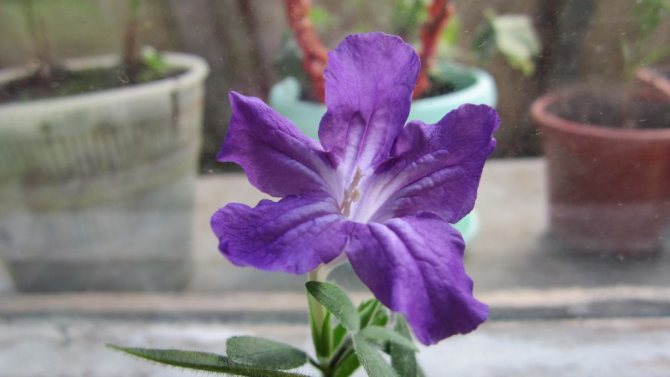

The transplant of young specimens is carried out annually, in early spring. This is done to increase root space and partially renew the soil. The pot needs to be taken a little larger than the previous one. But do not overdo it, otherwise the plant may not bloom, spending all its energy on increasing the volume of the roots. Adult plants over 3 years old are transplanted as needed.
It may be interesting: Passionflower - species and varieties
The soil
The quality of the soil is the second most important nuance of caring for Ruella after the humidity of the air. She definitely needs a light, breathable and permeable soil for flowering plants. The acidity should be close to neutral. The substrate is easy to prepare yourself:
- peat - 1 h;
- humus - 1 hour;
- light sheet earth - 2 hours;
- sod land - 2 hours;
- coarse sand or perlite - 2 hours;
Heat the resulting mixture in a water bath for 10 minutes to disinfect it.
Step-by-step transplant process
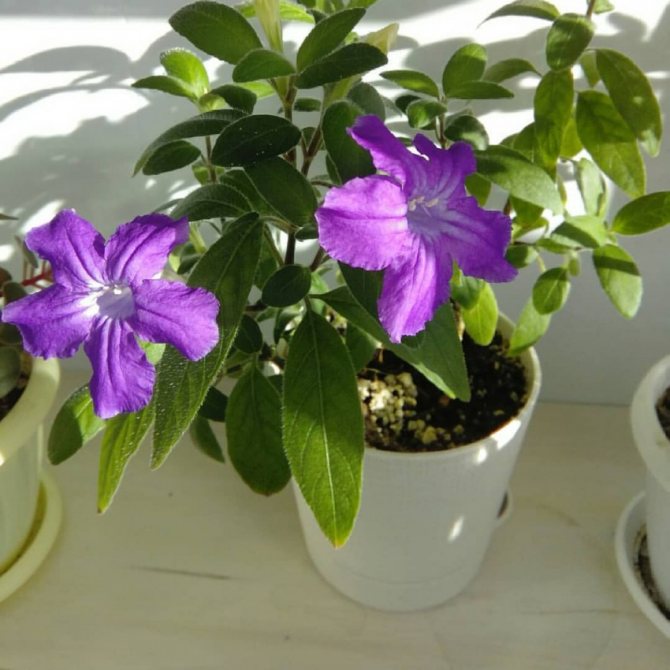

- Prepare a pot 3-4 cm larger than the previous one in diameter.There must be drain holes at its bottom. Place a layer of expanded clay or small pebbles on the bottom.
- Carefully remove the earthen plant ball from the old pot. Be careful not to damage fragile stems and leaves. It is not necessary to shake off the earthen ball so as not to damage the roots. If the plant shows signs of root disease, gently shake off the soil and inspect carefully. Take a sharp knife, disinfect it with alcohol or boil it, and cut off any rotten or dried roots, grabbing 2 cm of the healthy part. Sprinkle the cut sites with crushed charcoal or activated carbon.
- When transplanting, it is useful to mix complex dry fertilizers into the soil. So Ruellia will be able to get nutrients directly from the soil throughout the growing season.
Set up a support if you want the stems to grow upward rather than hanging out of the pot like an ampelous plant.
Reproduction of ruella
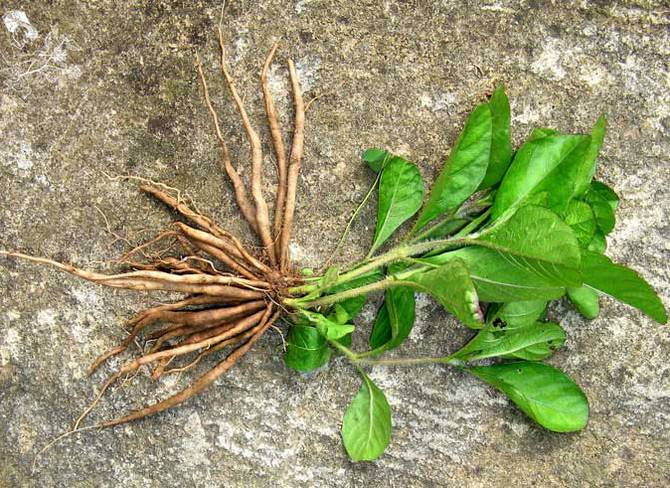

You can propagate ruella in different ways: by seeds, layering, cuttings or by dividing the bush.
Propagation by cuttings
When propagating by cuttings, it is important that they are not lignified. They need to be placed in water, and after a while the first roots will appear. Next, you need to plant them in the soil. The optimal amount is 5-6 cuttings per pot. Then the plants will appear more luxuriant.
Reproduction by layering
It is even easier to get new ruelle plants by layering. One of the shoots should be tilted to the soil so that one of the stem nodes touches the soil. Further, this place is fixed. After the roots appear, the layers are separated from the main flower.
Seed propagation
To obtain ruelia seeds, you need to press a little on them after ripening, as a result of which it opens and seeds appear. They are planted in moist soil at a shallow depth.
Important! Ruelia pleasing reproduces well enough with cuttings. With the help of cuttings, you can update the plant every year, so the ruelia will look much more beautiful.
Why does not ruella bloom
Poinsettia: home care and plant propagation options
Sometimes it happens that a plant bloomed for one year, and then, with the onset of September, does not throw out buds.
The reasons should be sought not in the flower, but in the conditions of its content:
- Little light is the main reason. This will be confirmed by the dull color of the greenery and elongated thin young shoots.
- Little heat - ruella is very thermophilic and if the temperature is low, the plant will not dare to bloom. If a beauty is standing on a window that is open all the time, cold autumn nights and temperature drops may be the reason. In winter, the cold can come from the glass or window frame, if it is not possible to remove the pot, you can put it on foam plastic.
- Drafts are something that ruelia is very afraid of. Lack of flowering, loss of decorativeness, falling foliage - these are all consequences of a draft.
- Growing in an oversized pot. In the presence of a large earthy coma, the flower will be busy building up the root system. Only when the ruella fills the pot with its roots will it bloom profusely.
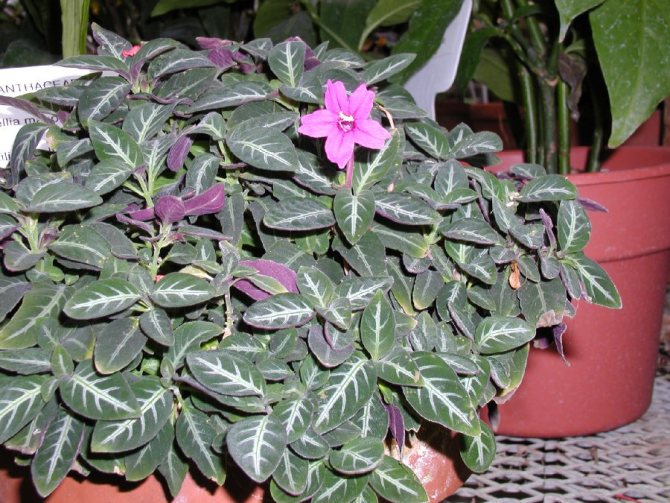

Pinching young shoots stimulates ruella to bush and discard buds. Young shoots bloom more actively.
Diseases and pests
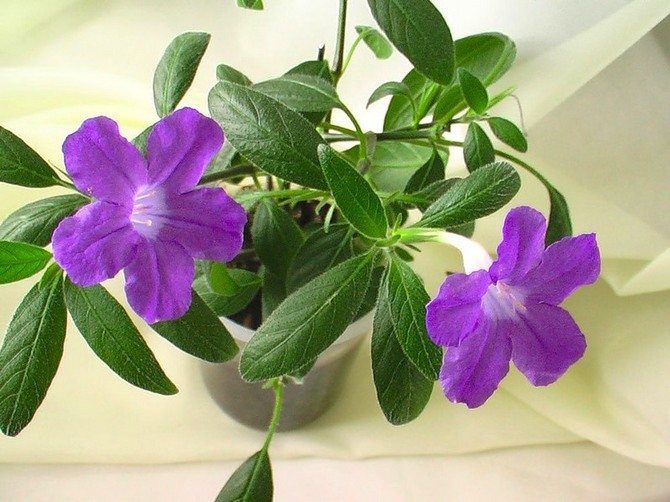

Ruellia resists various pests and diseases quite well, but it can be affected by the following parasites: spider mite - throughout the year, whitefly - mainly in summer. With excessive humidity and low temperatures, powdery mildew and gray rot most often appear.
Any insecticide is good against parasites, and to prevent diseases it is enough to keep the plant in good conditions.
Winter watering hole
With the onset of cold autumn days, I brought the flower into the house and put it on the window in the kitchen, it bloomed a little more and decided it was time to rest. I was not offended by him - he deserved the rest, and the beautiful leaves, even without flowers, delighted the soul. So that he would not be cold from the windowsill, they put Styrofoam under the pot. When the heating was turned on and warm dry air came from the batteries, the flower threw off the lower leaves, the stems were bare. I sprayed it and put a glass of water next to it, the leaves did not crumble anymore, but I really regretted that I had not guessed in time that he needed increased humidity. In addition, I noticed that some of the leaves around the edges dried up, curled up and turned brown. I often sprayed the flower, but the leaves never grew on the bare stems.
I often watered it with warm soft water - it turned out to be a water lover and sagged at the slightest drying out of the soil, but you can't fill the flower - the roots begin to rot.
On New Year's, my daughter came to visit and brought a book as a gift, from which I learned the name of my pupil - ruella.
The book contained only a brief description of the care of the flower, but, most importantly, I found out that it does not belong to the Gesneriaceae family, like Gloxinia, but to the Acanthus family and its relatives Fittonia, Jacobinia, Crossandra, Pachystachis, Afelandra, Beloperone, Hypestes, acanthus and many other home and garden plants.
Possible difficulties in growing ruelia
- Heat and excess sunlight can cause leaves to stain and curl. In this situation, it is enough to shade the plant or move it to a dimly lit place in the room.
- If the ends of the leaves dry up, then the plant needs a higher humidity. Otherwise, the plant may get sick and stop blooming.
- Excessively elongated young shoots, small leaves and a nondescript flower may be the result of a lack of lighting. If there is not enough natural light, then you can buy special lamps for plants.
- Yellowed and falling leaves indicate excessive moisture in the soil or the plant is in a draft.
- Ruellia begins to grow over time: the stems stretch out, the leaves fall off - it is necessary to cut off the bare shoots, thereby renewing the plant.
Common mistakes made by florists
The most common:
- The foliage withers, becomes soft. Excessive or insufficient watering. To fix the problem, you will have to assess the moisture content of the soil. When waterlogged, it is recommended to remove the flower from the pot, dry the soil and transplant it into a new pot with fertile soil.
- Yellowing of foliage. If ruella is exposed to cold air, its leaves begin to turn yellow. It is necessary to rearrange the plant to a different, safer place.
- The leaves are noticeably smaller in size, the stems are extended. This happens for 2 reasons: either the plant has already grown out, or it does not receive enough light. The situation can be corrected by cutting and rooting the plant. If the bush is still young, then it needs to be rearranged to another place with good illumination. It is recommended to arrange backlighting in winter.
- The tips of the leaves dry out. The problem is excessively dry air. You can eliminate it by increasing the humidity.
- Uncharacteristic spots on the leaves. Ugly streaks appear when the indoor air is too warm or are the result of sunburn. It is recommended to move the ruella pot to a cool room.
Healing properties
Many types of ruella are often used in the preparation of medicines.
The juice is used to treat the ears, the decoction is used to relieve scabies and itching, the grated leaves are used to treat ulcers. The smoke from a burning plant can relieve headaches.The roots have stimulating and tonic properties.
In addition to its medicinal properties, ruelia can be dangerous - its juice contains the poison saponin.
If you decide to grow ruelia at home, then caring for the flower will not be difficult, and you can always admire its large and bright flowers.
Accidental find
There are many flowers in my house. They came to me in different ways: I exchanged cuttings with friends, bought in flower shops and from grandmothers in the market, ordered from garden centers, lately I have been growing many home flowers from seeds.
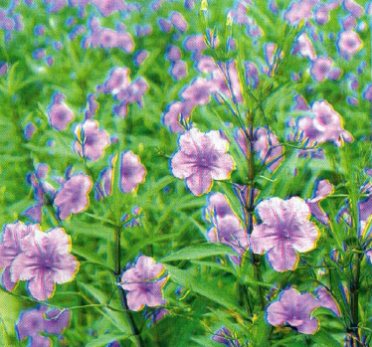

Well, this flower came to me (it's even a shame to say) from. trash can, standing near the stairs in one of the institutions of our city
Passing by, I noticed two pitiful dangling branches of a pale green color, but I knew for sure that I had never seen such a plant before. She tore off both stalks and brought home
At home, I carefully examined its prey: long soft velvety leaves with a barely noticeable pattern along the central vein of the leaf, and a stem with slight pubescence. For some reason I thought it was a relative of the well-known gloxinia.
I sprayed the cuttings with a weak (pink) solution of potassium permanganate against possible pests, prepared a low but wide pot, filled it with light nutritious soil from a cucumber greenhouse with the addition of washed river sand and planted both processes in one pot. I poured it with warm water and, covering it with foil, put it on the window in the kitchen. By the way, after the “bath” with potassium permanganate, the flower became noticeably prettier, and for the first time I thought: “How did someone raise their hand to throw this handsome man away, because even from the unsightly sluggish process it was clear that the flower was clearly good, but inept cultivation brought it to such a state and doomed to be thrown.
It was at the end of March, the day increased, the sun was shining with might and main, and the flower, after sitting for three days, began to lift its leaves.
I removed the film, sprayed it a little and noticed that the leaves darkened noticeably, a beautiful light green pattern appeared on them in the middle of the leaf. And the leaves themselves are velvet, as if dressed in a soft fur coat, and I wanted to iron them all the time. A month later, the flower was unrecognizable: it grew up to 40 cm, and the stems, densely overgrown with numerous leaves, began to tilt to the sides under their weight. Bought a circular metal garter, fastened the stems to it. All friends asked: what kind of handsome man is he and what is his name? But I didn't have an answer, although I searched for it in many magazines. A real surprise awaited me at the end of May: the stranger blossomed! Large bell-shaped flowers on a long stem covered the whole plant, they were bright pink with crimson veins. Friends who came to admire such beauty unanimously insisted that it was clearly a streptocarpus, because the flowers are very similar, but what the leaves are not like is, perhaps, some new variety.
The most popular for indoor cultivation are Carolina ruella (R. Carolinensis) and Portella ruella (R. Portellae). The first is the most unpretentious in conditions of detention and even tolerates a lack of sunlight. But the ruella of portella is capricious, and if in summer it has enough sun and warmth, then in winter it requires additional lighting and high humidity, otherwise it may die.
Popular types
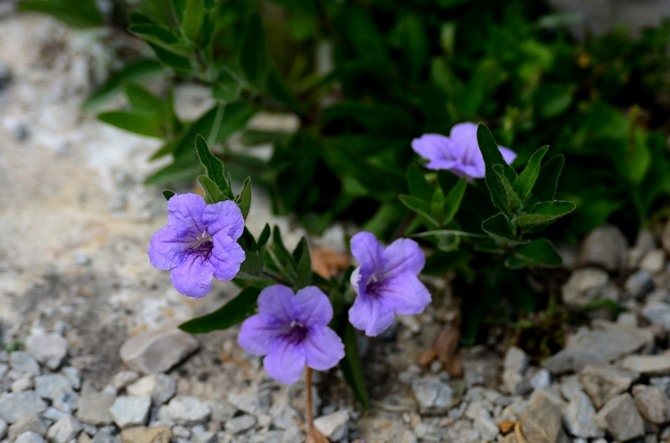

Ruellia Brittoniana - an evergreen shrub that grows up to 1 meter. The stems lignify at the base, long and wide leaves acquire a bluish tint under the influence of intense lighting. The plant has large flowers, the petals are purple. A feature of this species is the ability to grow it in colonies. The plant is unpretentious and is often grown in apartments.
Ruellia devosiana - grows mainly in the humid tropical forests of South America.Another name for the plant is Ruellia blue. The stem can grow up to 40 cm in height. The leaves are whole in the form of an ellipse, have a velvety surface, and a length of up to 7 cm. The upper surface of the leaf is dark green, the lower one is purple, the veins are whitish. The flowers are solitary, located in the leaf axils. They have a light lilac color with purple veins. The corolla at the fold is white or blue.
View of Ruellia portellae - grows in tropical rainforests of South America. The appearance of the plant is similar to blue ruella. The main difference is that Portella's ruella leaves are larger in size and brownish in color. In addition, the flowers are bright pink in color. This species can be grown as an unpretentious annual plant.
Ruellia large-flowered (Ruellia macrantha) - perennial abundant bush, reaching a height of about 2 meters. Ruellia leaves resemble an ellipse, large - about 10-15 cm in length, sharpen at the very end. The corolla is tubular, like a bell, is rather large - about 8 cm wide and about 12 cm long. The flowers are located at the tops of the shoots, they can be red, pink and lilac. Flowering time - from autumn to spring, subject to additional lighting.
Houseplants Flowering Houseplants
I do not get tired of admiring
More than ten years have passed since I got my ruelia, but every year in the spring I wait for her to bloom and I never get tired of admiring this wonderful flower! During the winter, due to the lack of sunlight, despite the illumination of lamps, the ruella stretches. If the flower is not more than two years old, I cut the stems in half, they soon become covered with numerous shoots, the bushes become fluffy and thick, and the cut cuttings can be rooted in water or perlite, when planting them in a permanent place, you need to pinch the top of the cutting, and it immediately begins to bush.
You can propagate ruella by cuttings and seeds all year round, but it is better to transplant and divide the old plant in spring.
Ruelia is also good in the ampelous version - in the spring, with the onset of warm weather, I take it out into the garden and hang it on an apple tree branch so that it does not burn with the sun. There are so many flowers on the cascading stems that the leaves are almost invisible! By the way, advice to those who will grow ruella as an ampelous plant is not to pinch the cuttings!
She is also good as a ground cover. And I found out about it quite by accident. The house was being renovated, and for two weeks I moved all the flowers under the apple trees to the garden. The long shoots of the ruella lay on the ground and took root where they were in close contact with it! She did not pull them out, but simply cut them off from the flower, and new seedlings grew until late autumn, tightening the earth, like a velvet carpet!
And before the frost, I dug up the plants and transplanted them into the house in wide pots in which the cypresses grew, and I got a beautiful composition - a tall, slender, handsome cypress and a painted carpet under it.
Ruellia's light loves bright, but diffused, and not direct scorching rays of the sun, from which the leaves burn. From a lack of light, flowering in spring is poor, so you need to select the best option. The flower also does not like drafts - it will instantly throw off all the leaves and flowers and then recover for a long time.
And you can spray it only in the evening - during the day, drops of water work like lenses, spots of sunburn are formed under them, and the flower looks unsightly.
I feed ruella once every ten days with fermented grass (in summer). I never noticed any diseases and pests, even when I brought a whitefly into the house with a purchased flower, there was no ruelia on it.
The flower is good for winter gardens, because in winter it needs high humidity and temperatures within 15-17 °, looks good in a composition with related flowers. Ruella is also beautiful if grown in a large aquarium, surrounded by congeners: Fittonia and Hypestes.Such a beautiful composition turns out!
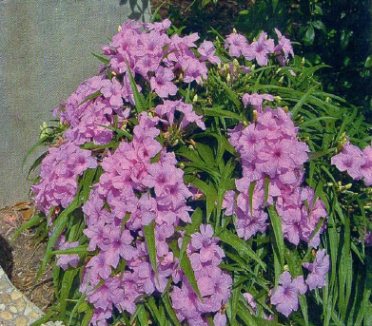

In general, ruella is a real find for flower growers, you just need to study her habits quite a bit, and she will bestow beauty and delight for many years! At home, in the humid tropics of America, it grows wild in the form of shrubs and herbaceous perennials, blooming with purple, white, pink, red and crimson flowers. American gardeners love to grow it in gardens in compositions on an alpine slide, in rocky gardens. And it is named after the French physician and botanist J. de Ruelle, who first described it.
Based on materials from the magazine "I Love Flowers"
More information on the topic:
Watering and feeding rules
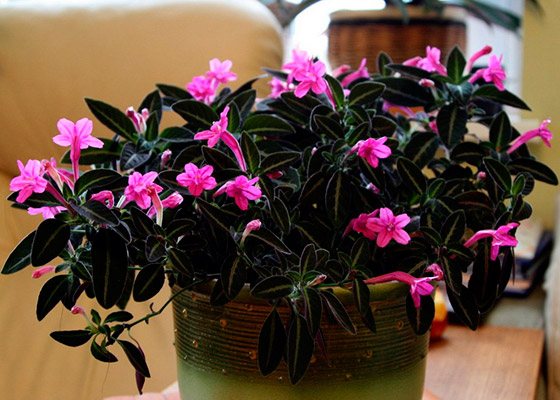

Ruellia is a flower that needs to be watered as needed. During the period of active growth, water it abundantly, avoiding stagnation of water in the pot. If you notice that the leaves are a little wilted, water the plant immediately.
If you allowed the earthen coma to dry completely, then do not rush to throw the flower away. In most cases, after the resumption of watering, it comes to life, new leaves appear in the place of fallen leaves. In winter, water the squeezed ruelia several times less often, not abundantly.
Ruellia Britton does not need spraying. But on very hot days, still spray it with warm water. During the heating season, keep the flower away from radiators. Bathe the plant occasionally in a warm shower.
From the beginning of April to the end of August, feed Britton's ruella regularly, at least every 2 weeks. If you overdo it, the flowering will stop. Take complex fertilizers for home flowering plants. During the rest of the year, fertilizing the soil under this flower is not worth it.
Signs and superstitions about ruelia
Ruella is unpretentious and graceful in cultivation, however, it requires a lot of attention. Therefore, people create and believe in superstitions associated with the plant. So, Dipteracanthus should be grown in apartments without small children. It is located indoors, to protect housing from evil spirits. In addition, dipteracanthus is considered a symbol of happiness in the home. The presence of a flower in the room carries a talisman against terrible diseases.
Summing up, it is worth concluding that Dipteracanthus is a plant with incredible beauty and splendor. Due to its decorative properties, it is used in design art. Flower varieties make it possible to enjoy new colors and comfort in the house. With proper care and timely rejuvenation of the shrub, it will delight for a long time with its splendor and decorative effect.
Air humidity
Ruellia needs high humidity. The ideal rate is 75-80%. In the absence of the proper conditions, humidifiers should be brought in to help, and the foliage should be regularly sprayed with warm water. Among the water procedures include wiping the leaves with a damp cloth, pouring from the shower.
Another method allows you to create optimal humidity - the use of wet peat, sphagnum moss or ordinary expanded clay. The drainage is poured / put into the tray of the container where the flower is planted. In winter, the plant is set aside from the windowsills located above the radiators or heaters. If this is not possible, then cover the heating devices with a sheet, blanket or any thick cloth.
Varieties
Not all ruelia varieties have taken root in the climatic conditions of Russia. The most common in our climate include those listed below.
- Ruella Portella. Herbaceous perennial with a characteristic shape and color of leaves. The upper side has a deep green tint, the lower side is burgundy. A white stripe stretches along the length of the central vein. The plant spreads along the ground, giving many layers, which spontaneously take root. The flowers are large, tubular, bright pink. Flowering lasts from early May to late August.
- Ruellia Large-flowered. The largest view of the existing.The stems are retracted by 1-2 m in length, they require a garter on the frame. Flowers are similar to volumetric gramophones, when opened, they reach a diameter of 7-8 cm. Most often, lilac, pink, blue-violet shades are found.
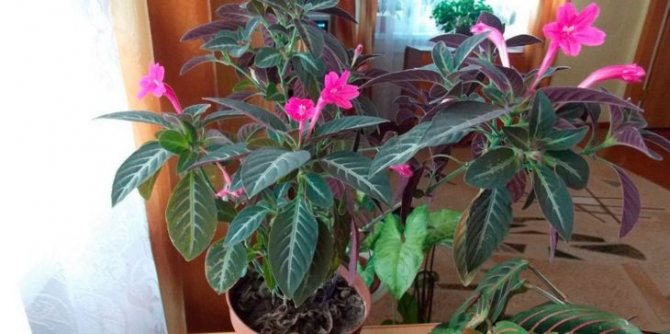

"Portella"
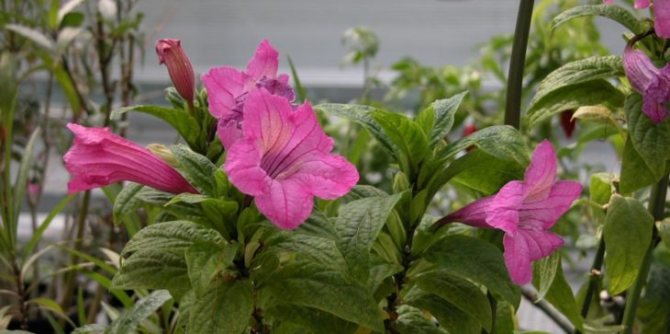

"Large-flowered"
- Ruelle the Beautiful. A perennial plant that raises the stems up in the first year of life, and then passes from the category of erect to creeping. Lanceolate leaves are covered with gray-silvery velvet villi. The variety has a long flowering period, and with proper care it can bloom all year round.
- Ruelle Britton. It is a voluminous bushes, reaching a height of 70-80 cm. Dark green glossy greenery in the sun shines with a metallic shade. From different angles it can look gray, grayish or bluish. The color of the flowers is rich purple, plum or lilac-blue.
- Ruellia Makoya. One of the most popular decorative varieties. The height of the bushes is average, about 60 cm. The shoots branch out abundantly as they grow, creating a voluminous crown. Leaves are dark green or bottle-colored with yellowish stripes along the veins. The back side is rough to the touch, covered with villi. The flowers are bright, burgundy or lilac-pink.
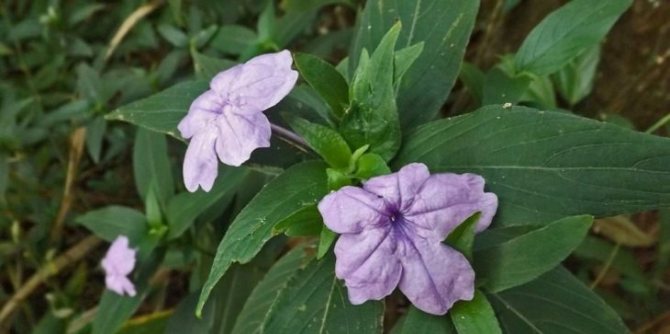

"Beautiful"
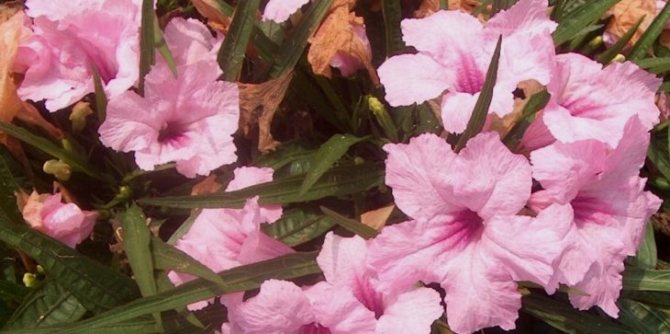

Britton
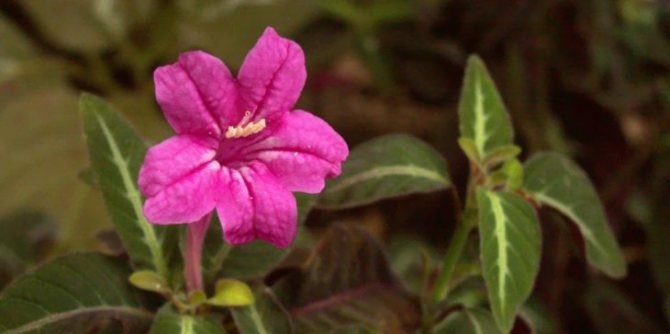

"Makoya"
Location
Ruelia does not like direct sunlight, so it is advisable to place it on windows facing the east or west side. Under diffused lighting, it feels good, is actively developing, but in winter it still requires additional illumination with special lamps. Especially if the pot is not on the windowsill, but in the back of the room. The lack of light will be noticeable along the internodes on the stems - the gaps between them will become wider, and the shoots themselves will be thinner.
In summer, it is recommended to take the plant out into fresh air, but protect it from drafts. It also does not tolerate tobacco smoke, water vapor, exhaust gases and combustion products. In hot hours, rearrange the pot in the shade or artificially create darkening with a curtain or paper.
Growing and care
The illumination of the site for planting ruelia is desirable good, but the plant perfectly adapts to conditions of light shade, albeit with some damage to the intensity of flowering. In partial shade, fewer flowers are formed and they are smaller. Plants thrive in dry or slightly moist, well-drained soil. In moist and rich soil, ruelia grows too quickly and chaotically, plants need to be planted in order to maintain compact forms. For the splendor of the bushes, it is recommended to pinch them.
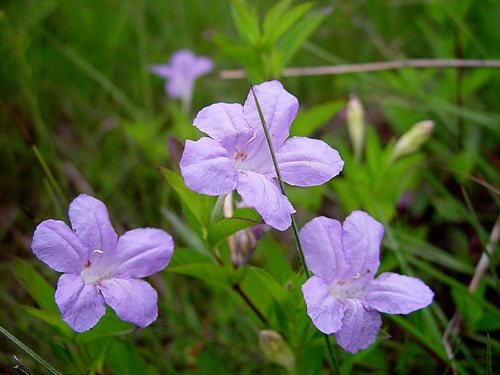

Inflorescence of ruelia squat (R. humilis)
In leaving, ruelia is unpretentious. Watering is necessary only during particularly dry periods. Despite its thermophilicity, ruelia is quite frost-resistant. Although at temperatures below 0 degrees, the ground part dies off, but when it returns to comfortable temperatures, the plant comes to life. Nevertheless, in the middle zone of the country, it can be grown as an annual.
Pruning
Since the plant grows very quickly and in less than a year, it can turn into a large bushy ball, it needs to be pruned regularly. A total "haircut" is usually done in early spring - bald shoots are completely cut off, the remaining branches are shortened to the desired length, necessary to create a voluminous crown.
The peculiarity of the cultivation of ruelia is that it can take both an ampelous form and a bush form. Accordingly, the approach to pruning will be different. In the first case, the length of the stems is monitored, in the second, 2-3 growth buds are pinched to form a spherical crown.

